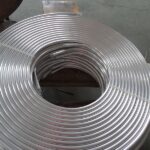Chilled Water Finned Tube Coils
Chilled Water Finned Tube Coils are components used in HVAC systems for cooling. They consist of a series of tubes with external fins that increase surface area for heat transfer. Chilled water circulates through the tubes, transferring heat to the fins, which then dissipate it into the surrounding air. These coils are efficient in transferring large amounts of heat and are commonly used in air handling units, chillers, and other cooling applications.

Chilled Water Finned Tube Coils
Benefits of
- Enhanced Heat Transfer Efficiency:
- The external fins significantly increase the surface area of the tubes, facilitating efficient heat transfer between the chilled water circulating inside and the surrounding air. This results in effective cooling with minimal energy consumption.
- Versatility and Customization:
- Available in various sizes, configurations, and fin designs, chilled water finned tube coils can be tailored to meet specific cooling requirements and space constraints. This versatility allows for optimal performance in diverse applications.
- Durability and Longevity:
- Constructed from materials like copper, aluminum, stainless steel, and others, these coils are designed to withstand various environmental conditions and operational stresses. They offer durability and long service life, reducing maintenance costs over time.
- Energy Efficiency:
- By optimizing heat transfer efficiency, chilled water finned tube coils help reduce the workload on chillers and cooling systems. This leads to lower energy consumption and operational costs, contributing to overall energy efficiency in HVAC systems.
- Effective Temperature Control:
- They play a crucial role in maintaining precise temperature control in buildings, industrial processes, and equipment. This ensures consistent performance and operational reliability, enhancing overall system efficiency.
Chilled Water Finned Tube Coils
Materials and Components of
| Component/Part | Material Options | Characteristics |
|---|---|---|
| Tubes | Copper, Aluminum, Stainless Steel, Carbon Steel, Titanium, Brass | – Copper: High thermal conductivity, ductile. – Aluminum: Lightweight, cost-effective, good thermal conductivity. <- Stainless Steel: Corrosion-resistant, durable. – Carbon Steel: Strong, cost-effective. – Titanium: Exceptional corrosion resistance. – Brass: Balance of thermal conductivity and corrosion resistance. |
| Fins | Aluminum, Copper, Stainless Steel | – Aluminum: Lightweight, cost-effective. – Copper: High thermal conductivity. – Stainless Steel: Corrosion-resistant, durable. |
| Headers | Copper, Brass, Stainless Steel | – Copper: High thermal conductivity. – Brass: Corrosion-resistant, machinable. – Stainless Steel: Corrosion-resistant, durable. |
| Manifolds | Aluminum, Stainless Steel | – Aluminum: Lightweight, cost-effective. – Stainless Steel: Corrosion-resistant, durable. |
| Frame/Casing | Galvanized Steel, Stainless Steel | – Galvanized Steel: Economical, provides protection against corrosion. – Stainless Steel: Corrosion-resistant, durable. |
| Coil Coating | Epoxy, Polyester, Phenolic | – Epoxy: Provides good corrosion resistance. – Polyester: Offers durability and color options. – Phenolic: Excellent chemical resistance. |
Chilled Water Finned Tube Coils
Performance of
Surface Area and Fin Design:
- Factor: The surface area of the fins directly affects heat transfer efficiency. Fins with optimized designs (such as spacing, thickness, and material) enhance the ability to dissipate heat into the surrounding air.
Material Selection:
- Factor: Choice of materials for tubes, fins, headers, and manifolds (e.g., copper, aluminum, stainless steel) impacts thermal conductivity, corrosion resistance, and durability.
Airflow and Airside Conditions:
- Factor: Proper airflow over the fins is crucial for heat dissipation. Factors include air velocity, temperature, humidity, and cleanliness.
Coil Sizing and Configuration:
- Factor: The size, arrangement (parallel or series), and overall configuration of the coil assembly influence its heat transfer capabilities.
Fluid Velocity and Temperature:
- Factor: Chilled water flow rate and temperature differential between the chilled water and the ambient air affect heat transfer rates.
Maintenance and Cleanliness:
- Factor: Regular cleaning and maintenance of fins and tubes prevent dirt, debris, and corrosion buildup that can impede airflow and heat transfer.
Environmental Conditions:
- Factor: External factors such as ambient temperature, humidity levels, and exposure to contaminants can affect coil performance.
Other Finned Tube Heat Exchanger We Manufacture
Air Handling Unit
Air Handling Unit (AHU) coil is a vital component in HVAC systems, designed to heat or cool air. It comprises tubes through which refrigerant or water circulates and fins that increase
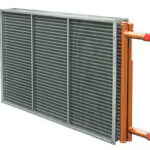
Fin Tube Evaporator Coil
Fin Tube Evaporator coil is a heat exchanger used in air conditioning and refrigeration systems. It consists of copper or aluminum tubes with aluminum fins attached to them.
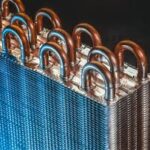
Fan Coil Unit
Fan Coil Unit (FCU) is a device used in HVAC systems to control the temperature and airflow in a space. It typically consists of a heat exchanger (coil) connected to a fan
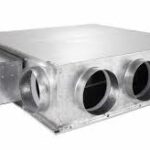
Hot Water Steam Coils
Hot Water Steam Coils are heat exchangers used in HVAC systems to transfer heat from hot water or steam to air. They consist of tubes, usually made of copper or steel,
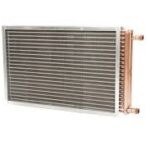
Air Cooled Heat Exchanger
Air Cooled Heat Exchangers (ACHEs) are devices that transfer heat from a fluid (liquid or gas) to the surrounding air. They use finned tubes to increase the surface area for heat transfer
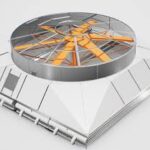
Rice Mill Heat Exchanger
Rice Mill Heat Exchanger is a device used to regulate and control the temperature during various stages of rice milling, such as drying, parboiling, and cooling.
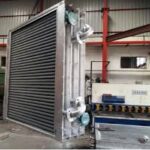
Foundry Sand Cooler
Foundry Sand Cooler is a piece of equipment used in foundries to cool hot sand after it has been used in the casting process. The cooling process is essential to prepare the sand
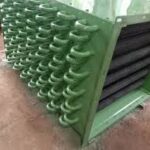
Air Blast Oil Cooler
Air Blast Oil Cooler is a heat exchanger used to cool hydraulic oil, lubricating oil, or other fluids in industrial machinery and automotive applications.
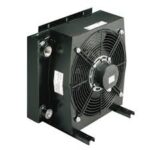
Aluminum Finned Water Tube Coils
Aluminum Finned Water Tube Coils are heat exchangers used in HVAC systems to transfer heat between air and water. They consist of tubes, typically made of copper or another material
